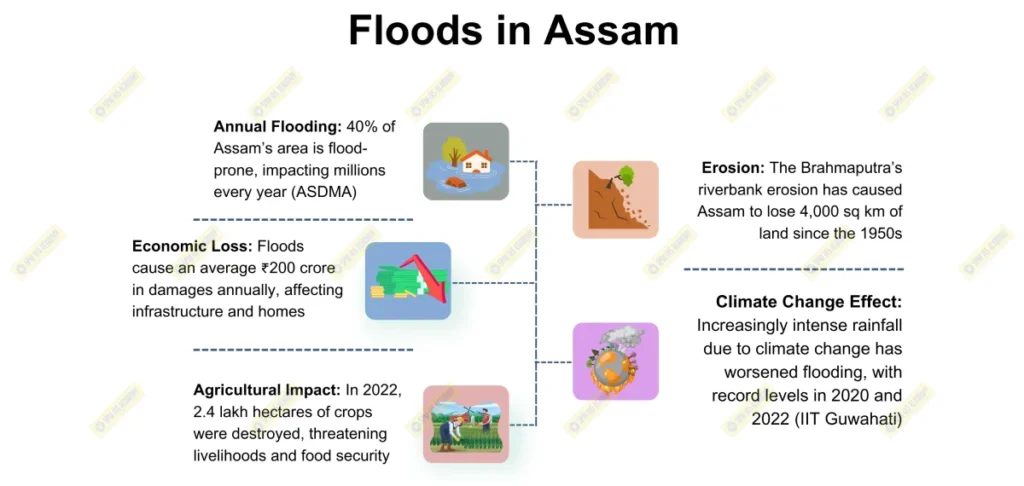Floods are a recurring natural phenomenon in Assam, affecting about 40% of the state’s land area annually. The Brahmaputra River and its tributaries cause widespread flooding, leading to substantial economic loss, yet these floods also offer untapped potential for sustainable irrigation and inland water transport (IWT). Assam is home to nearly 1,000 wetlands or beels, covering around 1.3 million hectares, which, if integrated with flood management, could play a critical role in water storage, irrigation, and enhancing connectivity. Utilizing floods and wetlands sustainably could transform Assam’s flood challenges into valuable assets.

1. Floods and Wetlands as Sustainable Sources of Irrigation
- Water Storage and Groundwater Recharge: Assam’s wetlands, such as Deepor Beel, can store floodwaters and facilitate groundwater recharge. Expanding wetland capacity to retain seasonal floodwaters can provide year-round water storage. According to the Central Ground Water Board (CGWB), enhancing wetland water retention could support irrigation needs during dry periods and recharge aquifers in flood-prone regions.
- Nutrient-Rich Silt and Soil Fertility: Annual floods deposit millions of tonnes of silt across the Brahmaputra floodplain, enhancing soil fertility. Studies show that silt deposits from floods reduce fertilizer costs by 10-15% for local farmers. Integrating floodwaters with controlled irrigation canals and wetlands can maximize nutrient flow, improving agricultural yields naturally.
- Storage Ponds and Interlinking with Wetlands: Constructing seasonal storage ponds alongside wetlands can control excess floodwaters, releasing them during dry seasons. This model, inspired by Bihar’s Aahar-Pyne irrigation system, could be adapted to Assam, providing a controlled water supply during droughts while also sustaining local agriculture.
- Flood-Resilient Crop Cultivation: Encouraging flood and wetland-resilient crops such as paddy, which thrives in floodplains, would optimize water usage. The National Mission on Sustainable Agriculture (NMSA) has reported that flood-resilient paddy varieties can boost crop productivity by 20-25% in flood-prone regions.

2. Utilizing Floods and Wetlands for All-Weather Inland Water Transport
- Natural Expansion of Navigable Routes: Floods naturally increase navigability across Assam’s water bodies, connecting 891 kilometers of river routes. Integrating Assam’s 1,000+ wetlands during the monsoon expands IWT options, similar to Bangladesh’s seasonal river networks, enabling cost-effective transport when water levels are high.
- Brahmaputra River Development under National Waterway 2: As part of the Jal Marg Vikas Project, the Brahmaputra has been designated as National Waterway 2 (NW-2), aimed at promoting year-round navigation. Leveraging flood-connected wetlands can ensure adequate water depth, reducing dredging costs and maintaining navigability for cargo vessels and passenger ferries.
- Floating Terminals and Small Ports: Developing floating terminals and ports along key wetlands and Brahmaputra tributaries would support transport during the flood season when road networks are disrupted. This strategy could help Assam become a major trade route within the BBIN (Bangladesh-Bhutan-India-Nepal) network, enhancing regional trade and connectivity.
- Economic Impact and Job Creation: A robust IWT system could boost Assam’s economy by facilitating cost-effective transport of local products, such as tea, crude oil, and silk, to neighboring states and countries. The Inland Waterways Authority of India (IWAI) estimates that efficient IWT in Assam could reduce logistical costs by 30-40% and create up to 15,000 jobs in the region.
3. Environmental and Biodiversity Benefits of Wetland Integration
- Flood Mitigation and Ecosystem Health: Wetlands act as natural buffers during floods, absorbing excess water and mitigating downstream impacts. According to Wetlands International South Asia, restoring Assam’s degraded wetlands could reduce flood-related damage by 15-20% and protect critical biodiversity in regions like Kaziranga and Manas.
- Conservation and Eco-Tourism: Integrating flood and wetland resources can create eco-tourism opportunities, providing economic incentives for conservation. Wetlands like Deepor Beel are already popular tourist destinations. Promoting wetland-based tourism can generate revenue while raising awareness about Assam’s rich ecosystem.
Floods and wetlands in Assam, when strategically integrated, offer a sustainable solution for irrigation, inland water transport, and biodiversity conservation. With 1.3 million hectares of wetlands and the Brahmaputra river as a major waterway, Assam has the potential to transform floods from a challenge into an asset. Through measures such as controlled storage ponds, the Jal Marg Vikas Project, and flood-resilient agriculture, Assam can ensure sustainable water management, economic growth, and environmental resilience. This integrated approach can help Assam harness its natural resources to support food security, connectivity, and long-term sustainable development.











